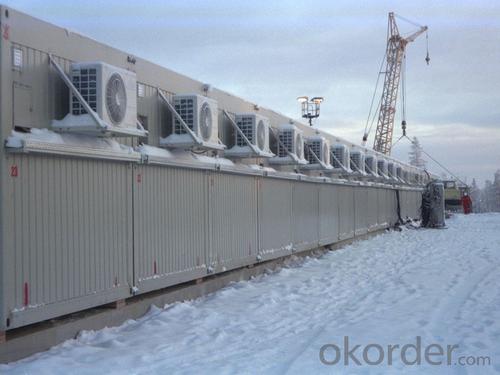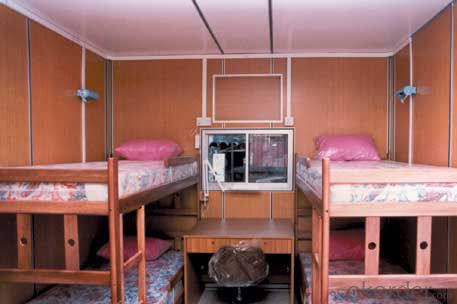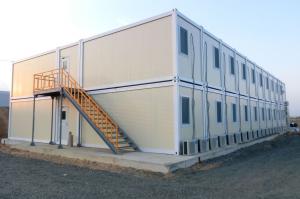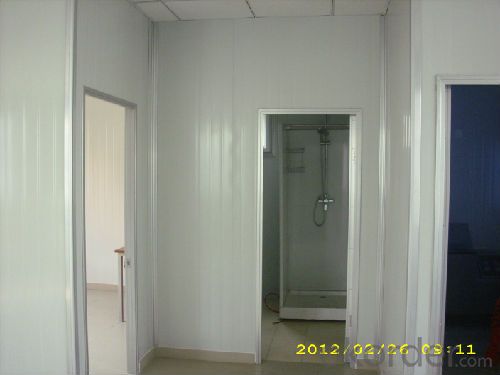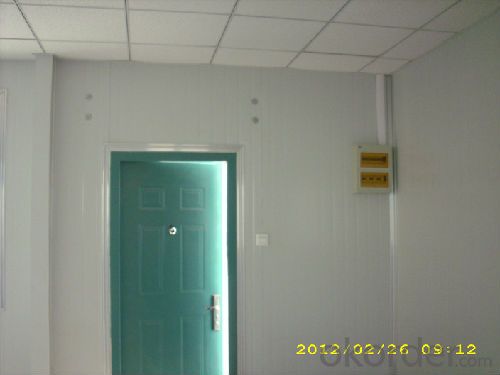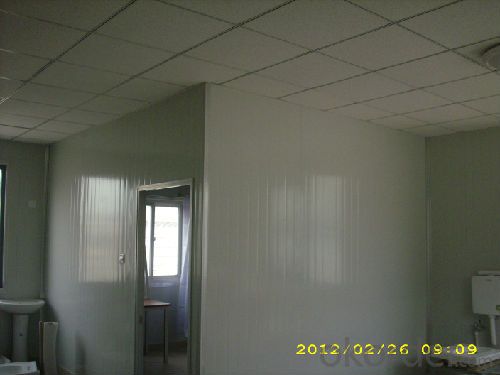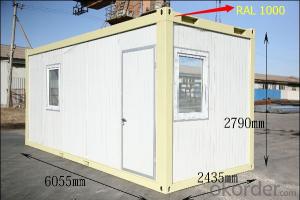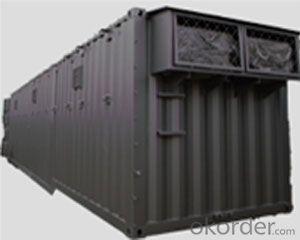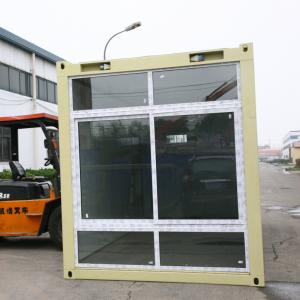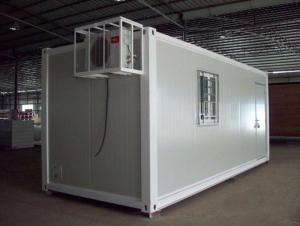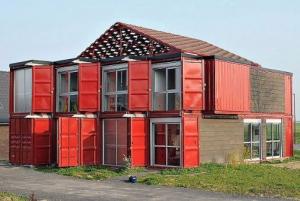Labor Camp for Construction Sites by Container Houses at Low Cost
- Loading Port:
- China Main Port
- Payment Terms:
- TT or LC
- Min Order Qty:
- 1 set
- Supply Capability:
- -
OKorder Service Pledge
OKorder Financial Service
You Might Also Like
Labor Camp for Construction Sites by Container Houses at Low Cost
1. GENERAL
The standard container for various purposes is suitable for international container transport. It is of appropriate external dimensions and has connections for lifting and fixing or compounding. The container is designed as a light construction consisting of floor and roof frames and corner profiles. The construction enables compounding of individual containers in longitudinal and transverse directions without limits. It also enables compounding of containers in 2 floors in height (ground floor + first floor), or in 3 floors in height for warehousing of these containers (ground floor + 2 floor). The wainscots of the container are made of light insulation panels and offer pleasant climate in the interior due to their building and physical properties. Delivery: Containers can be delivered assembled or individually in kits 648 mm high.4 kits can be bundled in packages 2591 mm high (ISO dimensions)
2. DIMENSIONS and TARE (ISO Standard 1161)
-External length 20/(inner length) 20: 6.055m/(5.851m) -External width/(inner width): 2.435m/(2.231m) -External height/inner height: 2.790m/(2.510m) -Tare: 1950 Kgs
3. STEEL FRAMEWORK
3.1 Material: cold formed steel profiles in a thickness of 3 to 4mm (bottom rails). 3.2 Surface working: electric galvanization min 15 μm, zinc compatible epoxy ground coat in a thickness of 30μm , final zinc compatible vinyl acrylic coat in a thickness of 60-70μm. 3.3 Fittings: 8 comer fittings (dimensions according to ISO standard 1161), rainwater pipe in the roof framework, plate thickness of 10mm excluding top corner fittings of the top kit of each bundle (20mm thickness) 3.4 Forklift openings: openings for fork-lift pockets in the floor framework, dim 88×250mm in a distance of 1200mm
4 .FLOOR
4.1 Composition: -external wainscot: flat galvanized steel sheet metal in a thickness of 0.5mm. -insulation filling: non combustible mineral wool in a thickness of 100 mm among steel transverse supports. Mineral wool density: 60 Kg/m3 -steam blockade: PE foil in a thickness of 80μm - plywood panel in a thickness of 18mm -glued PVC flooring covering in a thickness of 1.5mm. 4.2 Permitted loading : 2.50 KN/m2 4.3 Coefficient of thermal conductivity: l=0.039 W/mK 4.4 R value (Thermal Resistance) = 2.56 m2K/W 4.5 XPS insulation option: it is possible to choose an alternative insulation filling: extruded polystyrene (XPS) in a thickness of 80 mm among steel transverse supports. XPS density :35 kgs/cubic meter Coefficient of thermal conductivity: l=0.029 W/mK R value (Thermal Resistance) = 2.76 m2K/W
5. CEILING:
5.1 Composition: -external wainscot: flat galvanized and painted steel sheet metal in a thickness of 0.5mm. -insulation filling: non combustible mineral wool in a thickness of 100mm among plywood purlins. Mineral wool density: 60 Kg/m3 -steam blockade: PE foil in a thickness of 80μm -inner wainscot: chip wood panel in a thickness of 9 mm with a foil in white color; joining of chip wood panels with PVC profiles 5.2 Meteor water outlet: 4 each of PVC rainwater pipes, diameter 50mm in corner pillars 5.3 Permitted loading: 1.50 KN/m² 5.4 Coefficient of thermal conductivity: l=0.039 W/mK 5.5 R value (Thermal Resistance) = 2.56 m2K/W
6. FACADE WALLS
6.1 Side panels width: 1145mm; total panel thickness: 70mm. Five panels fit into the long side and two panels fit into the short side of container and they are fully interchangeable 6.2 Composition: -External wainscot: galvanized and painted steel sheet metal in a thickness of 0.5mm. -Insulation filling: non combustible mineral wool in a thickness of 50mm in the wood framework. Mineral wool density: 60 Kg/m3 -Inner wainscot: chip wood panel in a thickness of 9 mm with a foil in wood pattern (bright oak or white).
Joining of panels with PVC profiles. Final elements in the interior are made of chip wood panel in a thickness 8mm with a foil in wood pattern. 6.3 Permitted loading: 1.00 KN/m² 6.4 Coefficient of thermal conductivity: l=0.039 W/mK 6.5 R value (Thermal Resistance) = 1.28 m2K/W 6.6 100 mm insulation option: the framework can be modified so that mineral wool insulation reaches a thickness of 100mm. In this case R value (Thermal Resistance) goes up to: 2.56 m2K/W. Note that 100 mm thick wall panels are not fully interchangeable like standard 50 mm ones
7. DOORS Standard external door. Single fold, 40mm thick, made of: · a frame in prepainted aluminum · hot galvanized and prepainted steel sheets (inside and outside) · insulated with PL (polystyrene) Opening dimensions of 808×2030mm, furnished with a handle lock with 3 keys. Net opening dimensions: 754 x 1985 mm. Also 845 x 2000 mm net opening is available.
8. WINDOWS 8.1 Windows Option 1: made of PVC, white color, with dimensions 800×1100mm, glazed with double layer glass in a thickness of 4/15/4mm, with sliding mechanism (one side fixed and one sliding) Option 2: made of PVC, white color, with dimensions 800×1100mm, glazed with double layer glass in a thickness of 4/15/4mm, with tilt and swing mechanism Option 3: made of PVC, white color, with dimensions 800×1200mm, glazed with double layer glass in a thickness of 4/15/4mm, with tilt and swing mechanism 8.2 Rolling shutters Option 1: external PVC rolling shutters in PVC guides. Option 2: external Aluminum rolling shutters without insulation in Aluminum guides. Option 3: external Aluminum rolling shutters with insulation in Aluminum guides.
9. ELECTRICAL INSTALLATIONS 9.1 Standard: according to VDE 100 and CE regulations 9.2 Voltage: 220 V, 60 Hz single phase 9.3 Network connections: CEE-connection plus/socket, 3-pole 32 A, 220V, mounted on the top frame in upper corners of a shorter side wall 9.4 Inner distribution system: BVVB cables of suitable dimensions (6, 2.5, 1.5 mm) ,CE marked , flush-mounted. All cables (located on the ceiling and inside wall panels) run into CE certified plastic conduits. Roof cables and panel cables are connected with CE compliant jacks. All jack connections are protected inside CE marked and IP44 rated distribution boxes. 9.5 Protection: protective current switch (40/2E-0,03A), automatic fuses (B-characteristics) of suitable power (10A, 16A) 9.6 Earthing: galvanized connector with a steel plate of dimensions 30x80mm welded on the bottom frame
10. FAQ
1, Q: What is your MOQ? A: 1* 20GP 2. Q: What is the price? A: Please send us your project drawing, or tell us the order quantity. And the usage. 3. Q: what is the delivery time? A: within 30 days 4. Q: What is the payment term? A: 30% ADVANCED BEFORE PRODUCTION BY T/T, BALANCE BEFORE SHIPMENTS BY T/T
|
- Q: Are container houses suitable for areas with strict energy efficiency requirements?
- Container houses are a great option for areas with strict energy efficiency requirements. They can be designed and built to meet stringent standards by incorporating various sustainable features. To begin with, container houses can have excellent insulation to minimize heat transfer and reduce the need for excessive heating or cooling. By using high-quality insulation materials like spray foam, cellulose insulation, or rigid foam boards, the containers can be effectively sealed to prevent air leakage. Moreover, container houses can have energy-efficient windows and doors with low U-values and high thermal resistance. This helps to minimize heat gain or loss through the openings, contributing to overall energy efficiency. Furthermore, container houses can incorporate renewable energy systems such as solar panels or wind turbines to generate clean and sustainable energy. This not only powers the house but also reduces reliance on traditional energy sources, further enhancing energy efficiency. Additionally, container houses can be designed to maximize natural lighting and ventilation. By strategically placing windows, skylights, and ventilation openings, they can allow for ample daylight and fresh air, reducing the need for artificial lighting and mechanical ventilation systems. Lastly, container houses can utilize energy-efficient appliances and fixtures, such as LED lights, energy-saving appliances, and low-flow plumbing fixtures. These features help to reduce energy consumption and contribute to a more sustainable and energy-efficient living environment. In conclusion, container houses are suitable for areas with strict energy efficiency requirements. Through proper insulation, energy-efficient windows, renewable energy systems, natural lighting, and efficient appliances, container houses can meet and even exceed the energy efficiency standards set by strict regulations.
- Q: Can container houses be designed with multiple bedrooms?
- Yes, container houses can be designed with multiple bedrooms. The modular nature of container homes allows for flexible floor plans, making it possible to create separate bedrooms within the available space. Additionally, containers can be stacked or combined to create larger living areas, accommodating multiple bedrooms as needed.
- Q: Are container houses suitable for individuals who enjoy outdoor living?
- Container houses are indeed a suitable choice for those who relish the outdoor lifestyle. By incorporating sizable windows and open floor layouts, container houses enable an abundance of sunlight to filter in, thereby establishing a harmonious link between the interior and exterior spaces. Furthermore, container houses lend themselves to effortless customization and modification, permitting the inclusion of outdoor decks, patios, or even rooftop gardens, thus maximizing opportunities for outdoor living. With thoughtful design, container houses seamlessly merge indoor coziness with outdoor delight, rendering them an excellent alternative for individuals who have a passion for the great outdoors.
- Q: Can container houses be built with a traditional gallery or exhibition space?
- Yes, container houses can definitely be built with a traditional gallery or exhibition space. Container homes are versatile and can be customized to suit various purposes, including housing an art gallery or exhibition space. The modular nature of shipping containers allows for easy modification and expansion, making it possible to create spacious and well-lit areas for displaying art. Container houses can be designed with large windows or glass walls to maximize natural light, creating an ideal environment for showcasing artwork. Additionally, the industrial aesthetic of the containers can provide a unique backdrop that can enhance the overall visual appeal of the gallery or exhibition space. Moreover, container homes can be easily transported, allowing for flexibility in selecting a location for the gallery or exhibition space. They can be placed in urban areas, rural landscapes, or even temporarily set up in different locations for art events or exhibitions. In summary, container houses offer a cost-effective and flexible solution for creating a traditional gallery or exhibition space. With their adaptability, customizability, and portability, container homes can provide a unique and aesthetically pleasing environment to showcase art.
- Q: Can container houses be stacked?
- Yes, container houses can be stacked to create multi-level structures. The strong and durable nature of shipping containers allows for safe stacking, making them a popular choice for creating unique and efficient living spaces.
- Q: Are container houses customizable in terms of layout?
- Yes, container houses are highly customizable in terms of layout. The modular nature of shipping containers allows for easy modifications, such as adding or removing walls, windows, doors, and even combining multiple containers to create larger spaces. This flexibility allows homeowners to design and personalize their container houses according to their specific needs and preferences.
- Q: Are container houses suitable for individuals who frequently relocate?
- Yes, container houses are suitable for individuals who frequently relocate. Container houses are designed to be easily transportable, making them a great option for individuals who need to move frequently. They can be easily loaded onto trucks or ships and transported to a new location without much hassle. Additionally, container houses are compact and can be quickly assembled or disassembled, allowing for easy setup and takedown during relocation.
- Q: Can container houses be designed to have a children's play area?
- Yes, container houses can definitely be designed to have a children's play area. By utilizing the available space creatively and incorporating child-friendly elements, such as safe flooring, colorful walls, and age-appropriate play equipment, container houses can easily accommodate a designated play area for children.
- Q: How do container houses handle natural light?
- There are multiple ways in which container houses manage natural light. To begin with, they can utilize large windows or glass doors to allow abundant sunlight into the space. These windows are strategically positioned to optimize the amount of natural light that enters the house. Furthermore, skylights can be installed on the roof of container houses to bring in even more natural light. Another technique employed by container houses to handle natural light is the use of light-colored interior finishes and materials. Light-colored walls, ceilings, and floors reflect and enhance natural light, resulting in a brighter and more spacious atmosphere. Lastly, container houses can integrate various shading devices like blinds or curtains to regulate the amount of sunlight that enters the house and prevent overheating during hot summer months. All in all, container houses prioritize the utilization of natural light to create a welcoming and well-lit living environment.
- Q: Are container houses suitable for areas with limited access to emergency services?
- Areas with limited access to emergency services may find container houses to be a suitable option, but it is important to consider several factors. Firstly, container houses are designed to be durable and sturdy, as they are made of steel and can withstand extreme weather conditions. They are also resistant to fire, pests, and mold, which adds a level of safety and security in areas where emergency services may be delayed. Moreover, container houses can be customized and equipped with safety features to enhance their suitability for areas with limited emergency services. For instance, installing fire alarms, smoke detectors, and fire extinguishers can reduce the risk of fire. Similarly, incorporating security systems and secure doors can deter potential intruders and provide peace of mind. However, it is crucial to remember that container houses should not be considered a complete replacement for emergency services. While they can offer some level of protection, they cannot replace the immediate assistance provided by trained professionals during emergencies. Hence, individuals residing in areas with limited access to emergency services should have alternative plans in place. This may involve having a well-stocked first aid kit, acquiring basic first aid and emergency response skills, and establishing communication channels with neighbors or nearby communities. In conclusion, container houses can serve as a viable housing solution in areas with limited access to emergency services, but it is crucial to acknowledge their limitations and take proactive measures to ensure personal safety and well-being.
Send your message to us
Labor Camp for Construction Sites by Container Houses at Low Cost
- Loading Port:
- China Main Port
- Payment Terms:
- TT or LC
- Min Order Qty:
- 1 set
- Supply Capability:
- -
OKorder Service Pledge
OKorder Financial Service
Similar products
Hot products
Hot Searches
Related keywords







